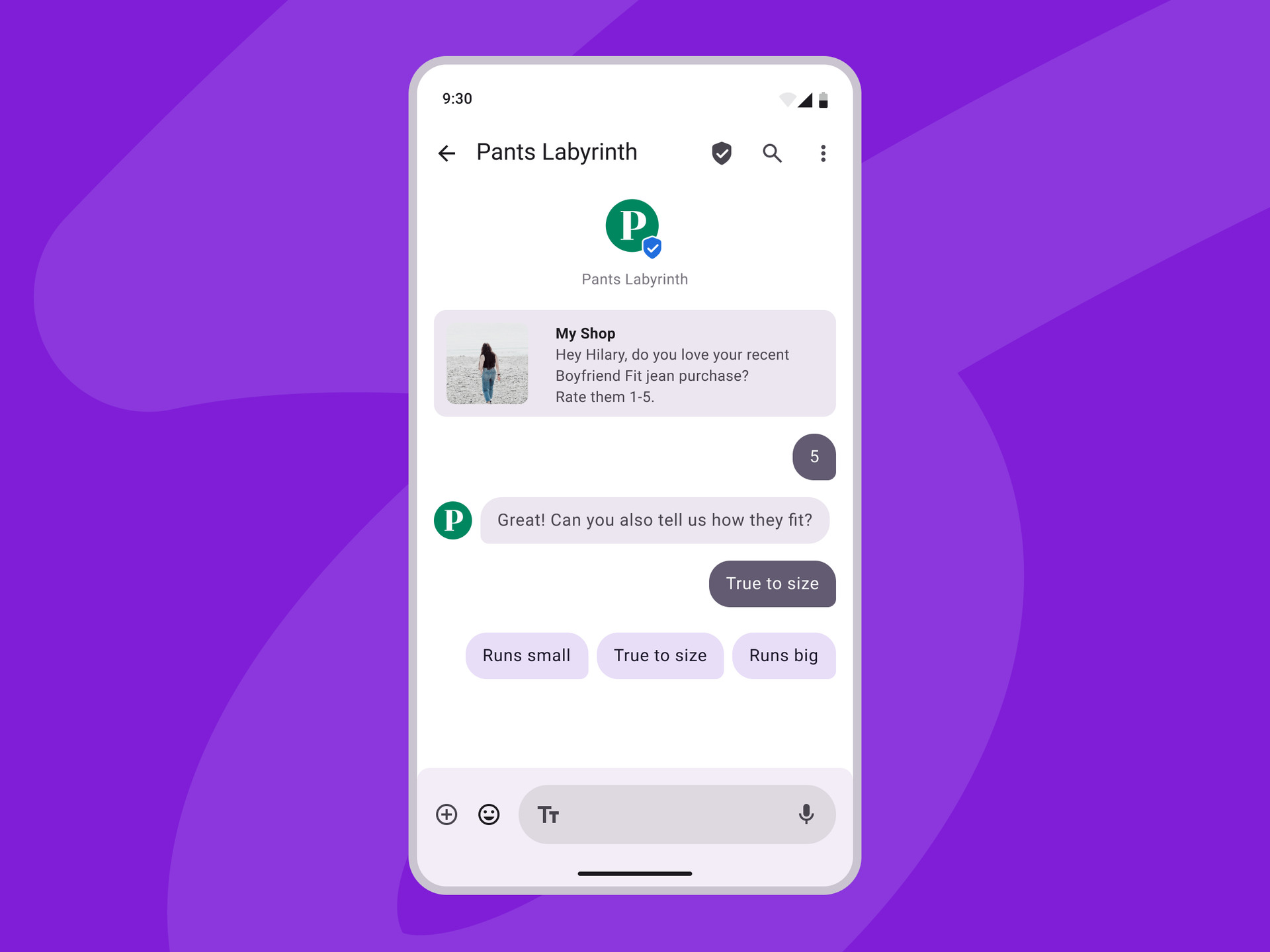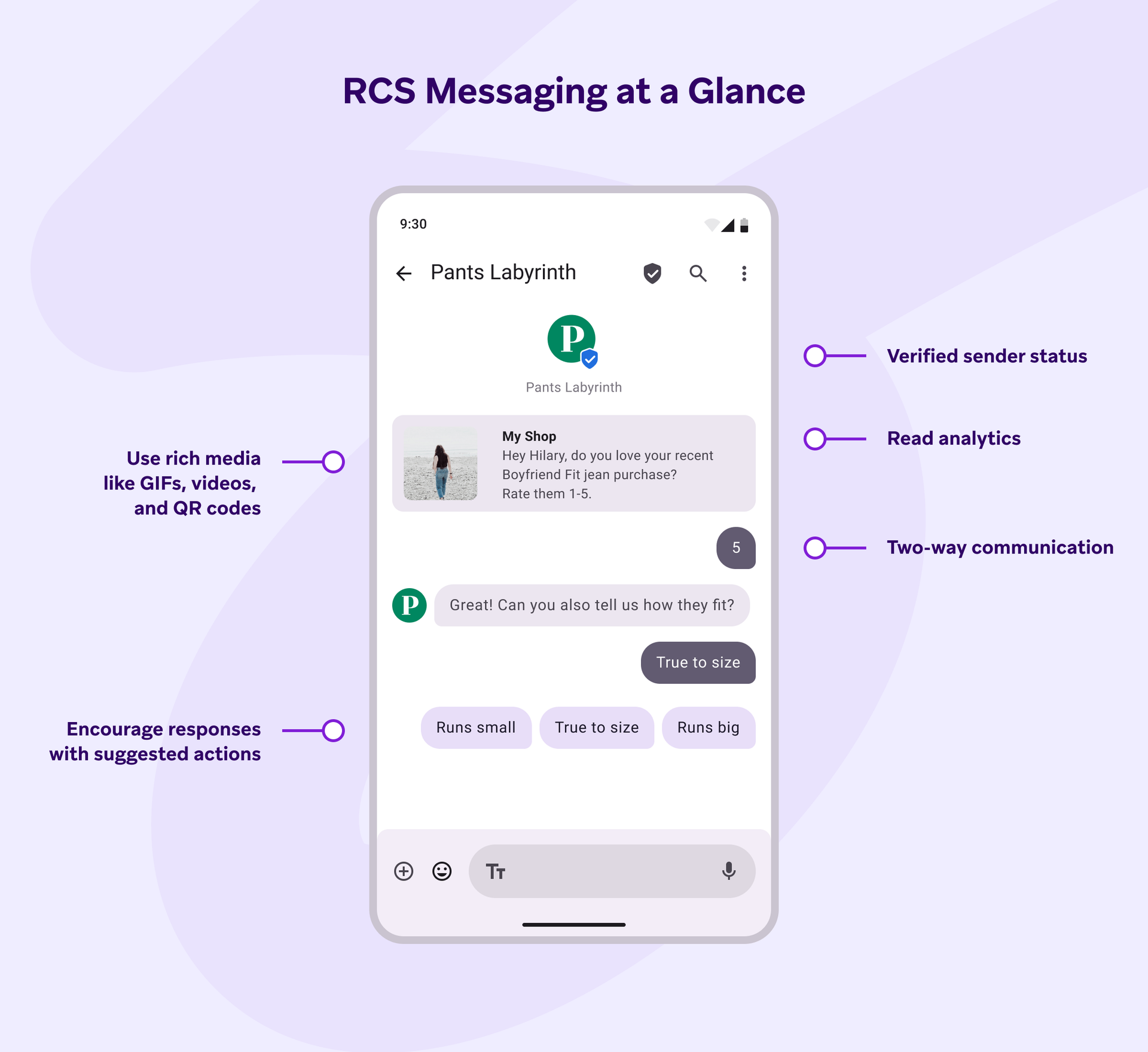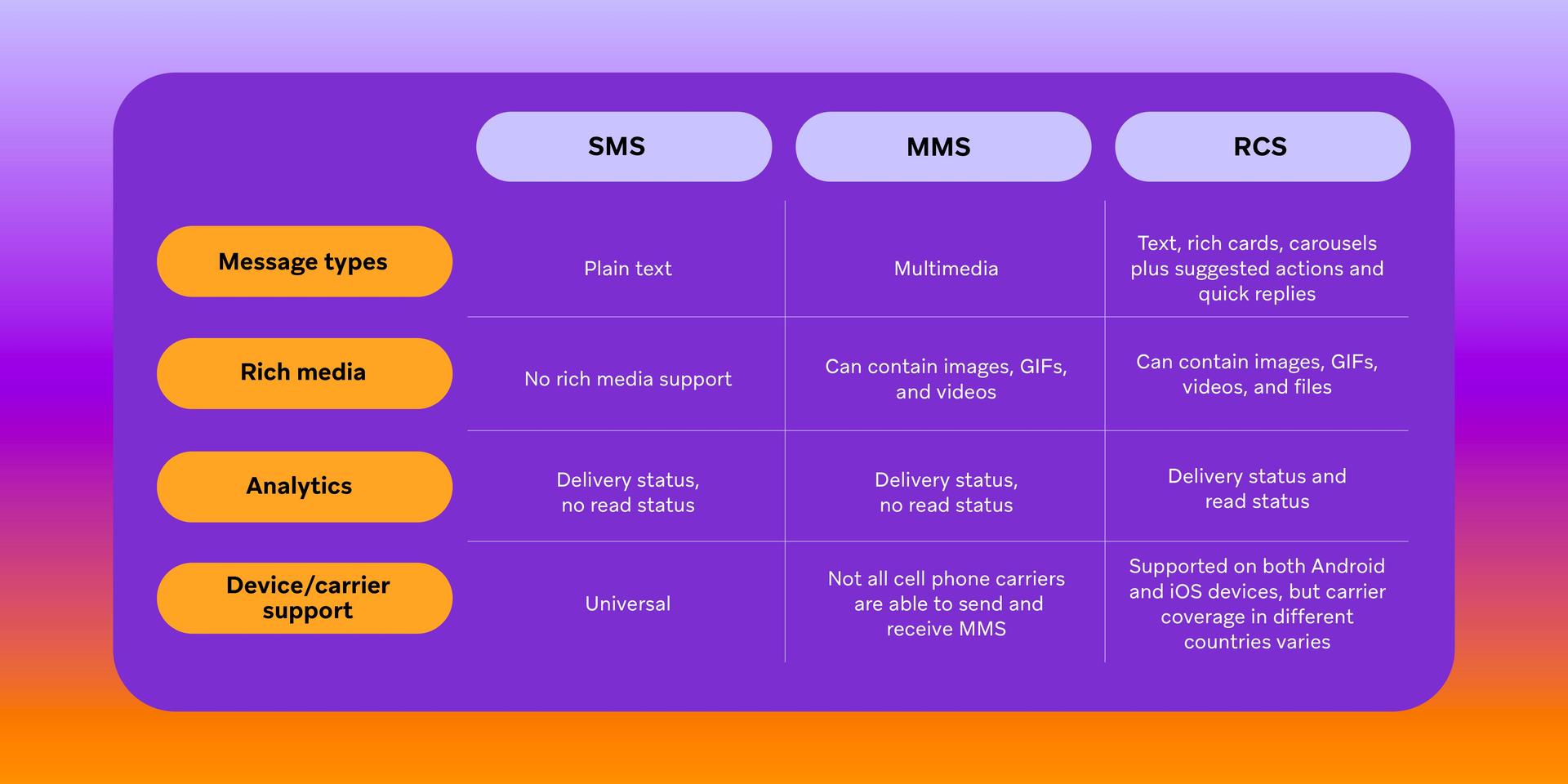The future of RCS messaging: Why RCS could be the next big marketing channel
Published on September 18, 2024/Last edited on September 19, 2024/11 min read


Team Braze
BrazeYou know about SMS marketing and how to use SMS for customer engagement. Now it’s time to get familiar with a similar channel that’s been around since 2007, but has been generating more buzz lately thanks to Apple’s iOS 18 update. That channel is RCS.
RCS, short for rich communication services, is a more modern take on SMS that offers richer capabilities for both peer-to-peer (P2P) and application-to-peer (A2P) messaging. On the P2P side, it offers features like group chat capabilities, support for voice messages, file sharing, and more. On the A2P side, RCS also offers marketers the ability to engage their customers with richer messaging experiences, including images, videos, and interactive buttons. More on that later.
While RCS has been available for Android users for some time, this messaging protocol is finally being supported by Apple with the release of iOS 18.
Because of the current hype around RCS, it’s a perfect time for marketers to learn more about RCS: What it is, its key features and capabilities, and how they can use it as a marketing channel.
So let’s dive in. In this guide we’ll cover:
- What is RCS?
- A brief history of RCS
- RCS messaging features and capabilities
- How does RCS work?
- Key players in the RCS landscape
- What is RCS Business Messaging (RBM)?
- The benefits of RCS Business Messaging and RCS marketing for brands
- Is RCS Business Messaging a fit for my brand?
- What’s the difference between RCS, SMS/MMS, and iMessage?
- RCS Marketing FAQs
What is RCS?
RCS stands for rich communication services (RCS). RCS messaging is an IP-based communications technology protocol that provides enhanced or "rich" capabilities for messaging, including text, voice, video, and file transfer.
In simpler terms, you can think of RCS messaging as SMS 2.0. Similar to SMS, RCS offers messaging capabilities without the need for a third-party app, but with richer and more advanced capabilities. On iPhones, RCS messages are delivered in the pre-installed iMessages app. On Androids, they’re delivered in the pre-installed Google Messages app.
RCS has similar features and capabilities to those that are available on other popular messaging apps, like WhatsApp and Facebook Messenger, such as typing indicators and the ability to let someone know you've read their message. It also offers—as the name suggests—rich media, such as the ability to send high-resolution pictures and videos, GIFs, and files such as PDFs. And it’s no surprise that RCS bears similarities to these other popular apps… it was designed to compete with them.
Let’s explore the brief history of how RCS came about.

A brief history of RCS
RCS messaging came about as a way to replace SMS messaging with a more advanced protocol that could compete with the likes of other messaging apps including WhatsApp, Facebook Messenger, and Apple’s iMessage. These apps started to provide more advanced and interactive features like support for read receipts, rich media, group chats, and other capabilities not available with basic text messages. The cellular industry knew they needed to keep up.
However, many factors have prevented RCS from becoming as ubiquitous as SMS and multimedia messaging service (MMS) messages, including Apple’s prior lack of support for RCS and the absence of universal support for RCS across carriers and devices.
That will all start to change with Apple iOS 18. As a result of this update, messages between Android and Apple users will be delivered via RCS, instead of SMS/MMS, providing customers on both platforms with a better messaging experience, including read receipts, typing indicators, and improved image quality.
A short timeline of RCS
2007 to 2010: The basic concept of RCS was first introduced by a group of industry promoters led by telecom companies. Their aim was to elevate traditional SMS and MMS messaging with features found in popular web-based messaging apps.
However, various mobile carriers involved in the creation of RCS ended up implementing their own versions of RCS, resulting in a fragmented market that initially failed to take off.
2016: The GSMA, an industry group representing the interests of mobile carriers, launched a unified version of RCS—the RCS Universal Profile—with the goal of creating a standardized, interoperable version of RCS designed to work across different mobile networks and devices. Carriers that deployed the Universal Profile guaranteed interconnection with other carriers.
2019: Looking to offer Android users a messaging experience on par with iMessage and other popular messaging apps, Google began releasing RCS to Android users. However, because of Apple’s lack of support for RCS, RCS was still not universally adopted.
2023: Google announced that over 1 billion monthly active users were using RCS in Google Messages. RCS was implemented as the default P2P messaging service for nearly all Android devices.
2023: Apple announced that it will start supporting RCS in late 2024.
2024: Apple releases support for RCS with iOS 18.
RCS messaging features and capabilities
RCS includes all of the basic functions of SMS, along with many of the flashier messaging bells and whistles consumers have come to expect from channels like WhatsApp, Facebook Messenger, and iMessage.
Key RCS messaging capabilities include:
- Messaging features like:
- Typing notifications
- Message delivery statuses
- Read receipts
- Message reactions
- User tagging
- Location sharing
- End-to-end encryption
- Opening messages in browsers, maps, and other apps
- Sending and receiving:
- Text-based messages
- Voice calls
- Video calls
- Voice messages
- Multimedia files, such as images (at a higher resolution than traditional MMS messages), videos, and documents
- Group chats
How does RCS work?
RCS messaging is an IP-based messaging service, operating through carrier data networks and WiFi. When RCS is supported and enabled on a consumer’s mobile device, they can automatically add reactions to messages, see when other users are typing, and add GIFs and other rich elements to their messages.
So are all messages sent by Android and iPhone users sent as RCS now? Well, not exactly.
RCS is automatically enabled on Android devices, so all Android to Android messages are sent using RCS. For iPhone users, messages between iOS devices will continue to be sent via iMessage, as Apple has made it clear that iMessage will “continue to be the best and most secure messaging experience for Apple users.” However, messages that are sent between Android and iOS devices will be sent via RCS when enabled, which will improve the messaging experience between Android and iPhone users.
Key players in the RCS landscape
Mobile carriers: RCS first came to be as a result of telecom companies looking to improve the SMS/MMS messaging experience. Today, these companies play a major role in the adoption of RCS across networks.
At the moment, three major US mobile carriers (AT&T, Verizon, and T-Mobile) offer support for RCS. As of June 2024, over 55 cellular networks support RCS worldwide.
Google: As the #1 driver of RCS adoption, Google has worked with global carriers and smartphone manufacturers to advance and promote the adoption of RCS with a goal of replacing SMS/MMS. The Google Messages app, which is the default messaging app on most new Android devices, uses the RCS protocol.
End users: With the rise of feature-rich messaging channels like WhatsApp and Facebook Messenger, consumers have high expectations for messaging experiences, which has driven the telecom industry to support richer experiences like RCS to meet consumers’ growing expectations.
Apple: Until September 2024, Apple historically refused to support RCS, instead opting to keep all messaging within their own P2P messaging app, iMessage, and falling back to SMS/MMS for messages between iOS and Android devices. In 2023, they announced that they would support RCS alongside iMessage in late 2024 to improve interoperability between iPhone and Android users. In September 2024, they released iOS 18 and started supporting RCS.
What is RCS Business Messaging (RBM)?
RCS Business Messaging, sometimes shortened to RBM, is the A2P version of RCS that allows companies to send marketing and transactional RCS messages to customers.
Historically, Apple's lack of support for RCS ultimately stifled the protocol's growth. With carriers having less incentive to support RCS, SMS continued to be the #1 choice for marketers looking to reach both Apple and Android users with text message marketing. However, with the recent release of iOS 18 ushering in a new era of RCS on iPhones, this update will likely accelerate the adoption of RCS Business Messaging, since marketers can now engage their entire user base (across iPhone and Android users) with richer messaging experiences.
The benefits of RCS Business Messaging (RBM) and RCS marketing for brands
For brands, RCS messaging means the potential to create richer messaging experiences. For example, marketers can include higher-quality images, interactive buttons, and suggested actions in their messages. Imagine carousels of menu items alongside text descriptions or a few suggested responses that a consumer can select to provide feedback after a recent purchase.
With RCS, marketers also gain more robust analytics, so they can gain insight into who is reading and interacting with messages, something that the SMS channel lacks. All of the rich capabilities of RCS offer brands the potential for higher engagement—and higher conversions. In the future, businesses may even be able to allow customers to make their airplane seat selections directly within their RCS messages, without recipients having to navigate to a website or app.
Benefits of RCS Business Messaging include:
- Robust message types, such as text, rich card, and carousels
- Rich media like images, videos, and other files
- Two-way messaging capabilities and interactive features like suggested actions
- Verified sending for increased consumer trust and safety
- Branding displayed at the top of the message thread, including logo, brand name, and badge
- Comprehensive reporting and analytics, like read metrics, clicks, deliveries, and failures

Is RCS Business Messaging a fit for my brand?
Given the benefits of RCS marketing for businesses listed above, this channel may be a fit for your brand. However, there are some important factors to keep in mind.
Cost: Cost is a key consideration for marketers looking to maximize their budget. Because RCS offers richer capabilities than SMS, it may cost more in some instances. Marketers should consider the cost of sending SMS versus RCS. For some brands, using both channels for different use cases might be the right choice.
Deliverability: Deliverability is also a factor, since carrier coverage varies in different parts of the world. Depending on where your customer base is located, you may opt for SMS, RCS or some combination of both. Not to worry though. If a message cannot be delivered via RCS (because either the carrier or the device does not support it), the platform you are sending through may support an SMS fallback.
Regulatory requirements: As with SMS, there are regulatory requirements to follow with RCS Business Messaging. Brands are required to go through a verification process which will provide them with a verified RCS sender, which shows users they are receiving messages from a brand they trust. As always, be sure to talk to your legal team before launching a new channel like RCS.
What’s the difference between RCS, SMS, and MMS?
Here are overviews of the key differences (such as SMS vs RCS features) between these messaging channels.

SMS overview: These are plain text messages that don’t support rich media, like high-resolution images, GIFs, videos, and more.
SMS availability: Universal. Since not all cell phone carriers and devices offer support for RCS or MMS, SMS may continue to be a default channel when other options are not available.
MMS overview: These multimedia messages can contain images, GIFs, and videos, offering a more engaging experience than SMS.
MMS availability and other considerations: Not all cell phone carriers are able to send and receive MMS. In these cases, multimedia messages will be sent as regular SMS messages with an image link the recipient can click to view. Note: Although MMS is widely used in the US, not all regions support MMS messages. Before you start building out a global MMS strategy, take the time to assess whether each market you’re looking to reach can support this message type.
Short codes that have not been enabled for MMS must go through a provisioning process, which can take as long as the process of applying for a short code (8 to 12 weeks).
Certain SMS phone number types, including alphanumeric sender IDs and SMS-enabled toll-free phone numbers, are unable to send MMS texts. So make sure you choose your sending numbers carefully!
RCS overview: These messages are the next evolution of SMS, offering rich features available via popular messaging channels like WhatsApp and Facebook Messenger.
RCS Availability: RCS coverage still varies by country, depending on carrier support. While many carrier networks in certain parts of the world—including Europe and Latin America—have implemented RCS, some mobile networks are still working on implementing RCS. We expect to see an uptick in carrier support with the rollout of iOS 18.
As with MMS, if a message cannot be delivered via RCS (because either the carrier or device does not support it), it will be delivered via SMS by default.
Key Takeaway
With RCS being the messaging service of choice for Android users and now available on Apple devices, RCS campaigns are likely to become more popular as marketers look to engage their customers with richer, more interactive messaging experiences.
Related Tags
Releated Content
View the Blog
A day in the life of a data scientist on the BrazeAIᵀᴹ forward-deployed engineering team

McKay Jensen

The new inbox reality: How iOS changes are reshaping email marketing

Aparna Prasad

Experience optimization: Turning data insights into better journeys
